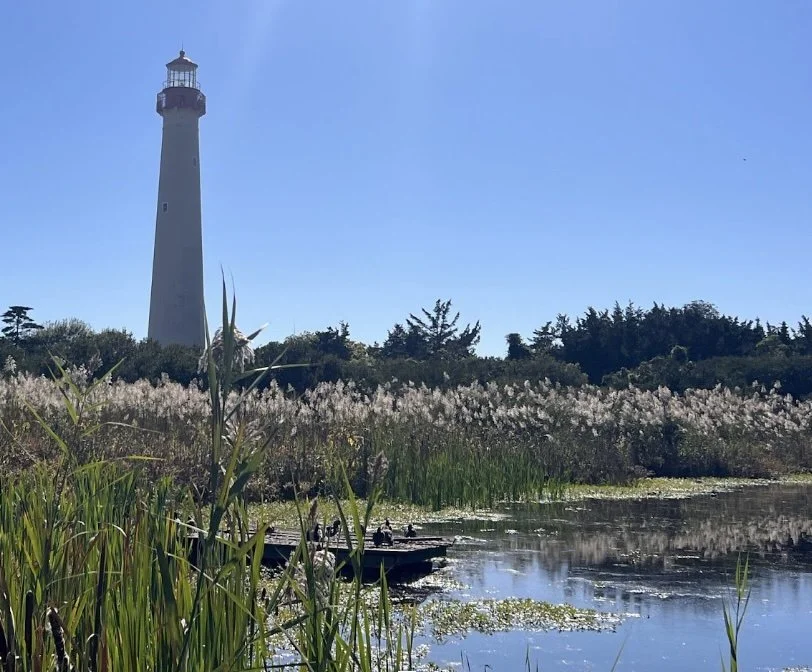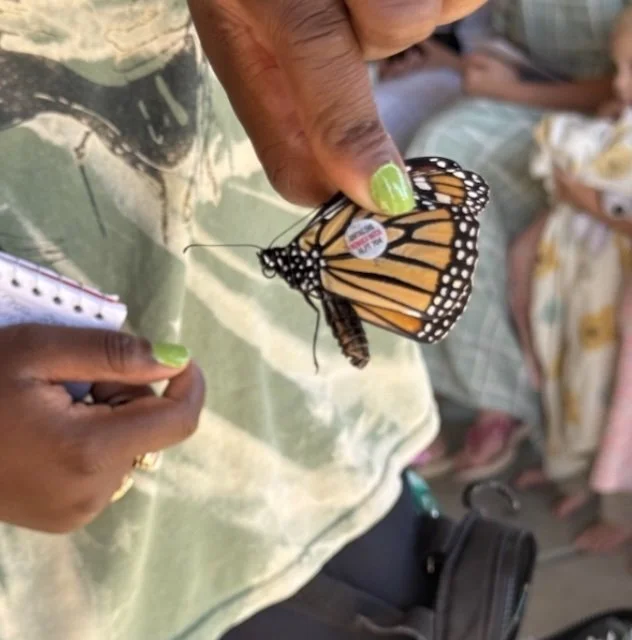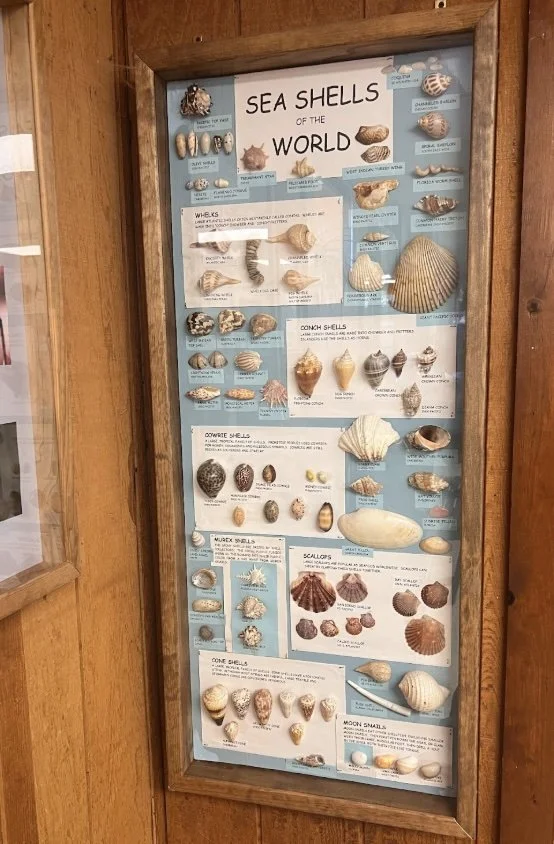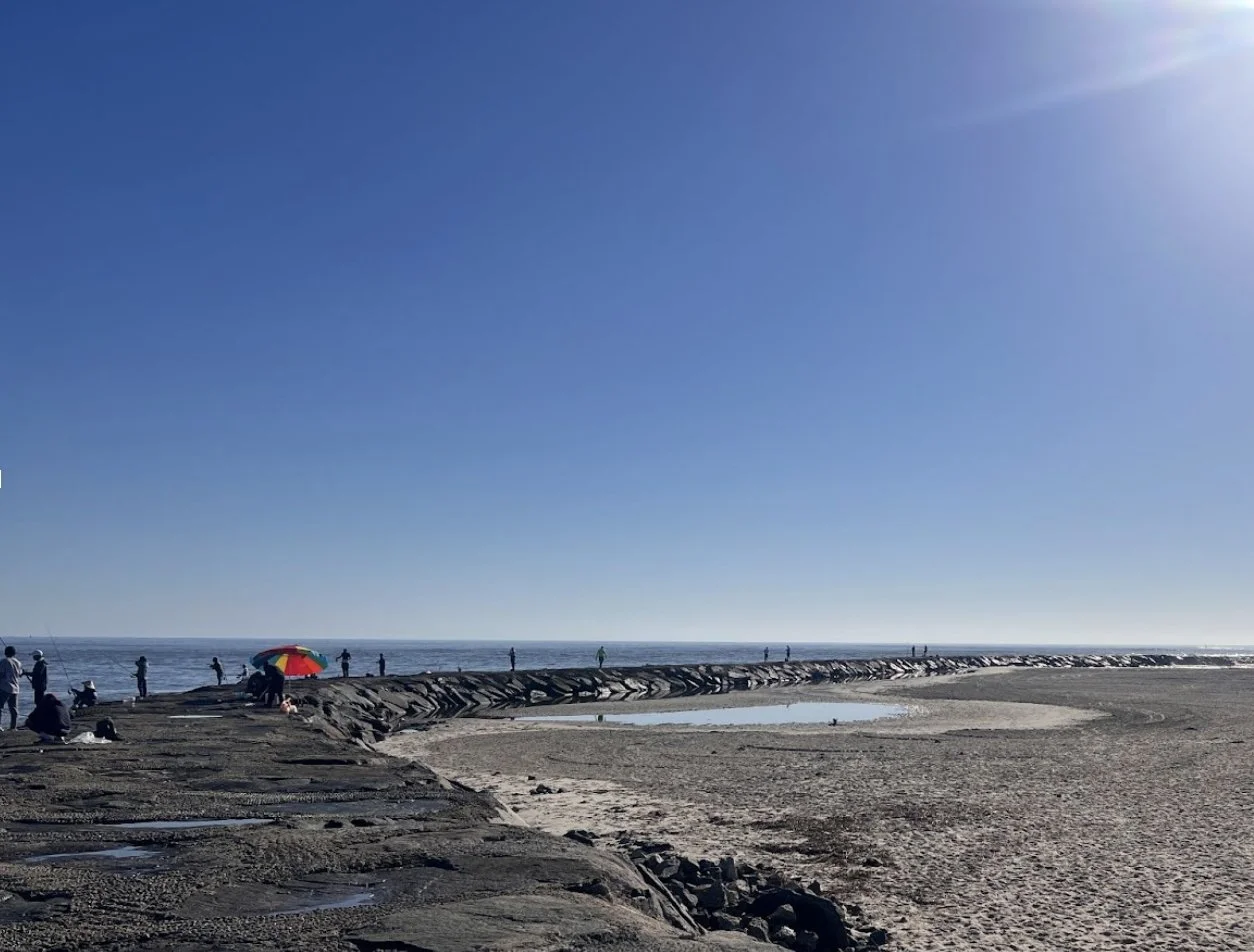Photo: Cape May Lighthouse, Alan Kotock via Pixabay
McKenzie Ingram
Driving to Cape May. Photo: Ajani Simmons
Saturday morning was anything but cozy, sleepy, fall vibes for our birders chasing the thrill of fall migration. 22 birders, including experienced guides Tom Wood, Herlitz Davis, and Judy Gallagher in tow, awoke before sunrise, loaded into vans, and began our journey from Northern Virginia to Cape May, NJ! Our eyes were set on this far away destination because of its geography. This peninsula is perfectly aligned with the Atlantic Flyway, one of the four “avian superhighways” in North America, making it a world-renowned birding hotspot.
Our group after arriving in Cape May via the ferry. Photo: Ajani Simmons
After our drive from Virginia, we crossed into New Jersey from Delaware via the Cape May–Lewes Ferry, which offered scenic views and unique birding opportunities along the way. Aboard the ferry, we saw Laughing Gulls, Forster's Terns, a pair of Brown Pelicans, and many other water-loving birds. Many species are in their non-breeding plumage this time of year, making identification trickier but rewarding.
Cape May Lighthouse. Photo: McKenzie Ingram
Once in Cape May, we hurried to the nearby Cape May Point State Park , where we enjoyed a quick lunch before an afternoon of birding fun under the observation of the nearby 157-foot-tall Cape May Lighthouse which has overlooked the entire peninsula since it was first lit in 1859.
When you hear “fall migrants” one might expect to only see avian migrants such as warblers, the infamously colorful tiny birds that flood the skies on their migrations every spring and fall. However, a plethora of species are also on their way to warmer temperatures or waters this time of year - something we quickly learned during our time at the park. At Cape May Point, Monarch butterflies and dragonflies stop briefly in the park along their migration to gain their strength before crossing the Delaware Bay.
Monarch butterfly sporting a band. Photo: Jenn Crawford
These Monarch butterflies are part of what researchers call “the monarch super generation.” Unlike their close relatives, these monarchs' reproductive cycles are on hold. They do not complete their life cycle in a mere four weeks, and they are migrating south, the opposite of what their parents or grandparents did. Some fly over fifty miles a day on their way to their winter homes in Mexico! Some guests even had the pleasure of watching a butterfly banding demonstration provided by the Monarch Monitoring Project while visiting the park.
This monitoring project is hosted under the Cape May Bird Observatory (CMBO) founded in 1976 by NJ Audubon. The CMBO is a beacon for migratory species research such as annual counts, censuses of species, and other environmental education projects. For instance, the park’s nearby Cape May Hawkwatch, is one of many birding attractions that also conducts conservation-driven studies through the CMBO. We were especially grateful for the expert advice given by the seasonal naturalist hired by NJ Audubon. The naturalist happily answered our questions and aided us in bird identification. On the platform we saw a male Belted Kingfisher, American Kestrels, and a Peregrine Falcon, among others.
Sea Shells of the World exhibit at the CMBO Nature Center. Photo: McKenzie Ingram
The park’s Nature Center and Museum provided us with more educational opportunities such as seashell exhibits, live reptiles, and other information relevant to visitors. Onsite there were several trails for us to take that gave up-close views of woodland habitats, marshlands, ponds, beaches, dunes, and other habitats critical for migrants. One group even saw a Black Snake consuming a juvenile squirrel on the side of the trail. While the snake was enjoying his meal, the nest of squirrels made warning calls from the pine tree above, making this an especially memorable sighting.
After leaving Cape May Point State Park, we traveled up to Ocean City, NJ where we enjoyed dinner at the nearby boardwalk full of Saltwater taffy shops and attractions before calling it an early night.
The next morning we drove back down to the Avalon Seawatch. This site was chosen by NJ Audubon for its location because the northern tip of Avalon extends a mile farther out into the ocean than the coastline to the north. Southbound seabirds that are following the coastline pass very close to this beachfront. According to their webpage, there are an average of almost 800,000 seabirds counted here annually, with around 70% of all the migrant seabirds passing in a mere five week period in the fall.
Avalon Seawatch. Photo: McKenzie Ingram
On day two we were accompanied by another seasonal naturalist and local guides who are experts in identifying both local and migrant species that frequent Avalon. While there, we watched Royal Terns fly above the water while about seventy Sanderlings sat on the jetty, completely exhausted from their latest leg of their migration journey.
Here our guide Judy discussed the importance of coastal marshlands and shared her knowledge on the highly invasive marsh reed known as Phragmites australis, that line the trails and beaches we visited almost the entire journey.
Our guide Judy Gallagher addressing the group at Avalon Seawatch. Photo: McKenzie Ingram
Our next stop was the 200-acre South Cape May Meadows preserve established by the Nature Conservancy. Along the one-mile trail loop, we saw several fall migrants such as Common Yellowthroats, Gray Catbirds, Ospreys, and more. Along the way our guides shared detailed identification tips while local guides provided historical information on the restoration projects in the region.
For our final stop, we made our way to the CMBO Northwood Center. Here there is a plethora of field guides from around the world, birding books, spotting scopes, binoculars of all kinds, and other birding goodies available for purchase to fundraise for such programs and projects.
From here, the group rode back across the Delaware Bay to catch last glimpses of seabirds and ponder the many brilliant sights we left behind in NJ.
This trip was made possible in part to the Virginia Department of Wildlife and grant funding provided to support new birders enjoying the nature around us. As a result of that program, over half of our group were new birders who have never had a chance to see a migration hotspot.
At the trip’s conclusion, we spotted over forty species of birds. These species, along with the butterflies, plants, and everything in between, reminded us that even in the midst of life’s biggest journeys, some more challenging than we ever anticipated, there are still many moments of connection, amazement, community, humor, joy, and more to look forward to. And that, to me, is what made our Fall Field Trip to Cape May, NJ truly special.
The 2025 NVBA Cape May crew. Photo: Tom Woods









